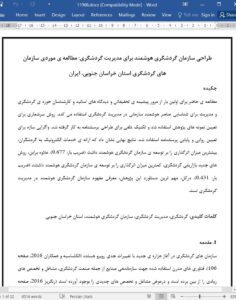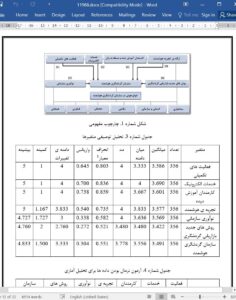Abstract
The present study uses a review of the literature and the views of tourism and management professors and experts in order to the identification of organizational intelligence elements in tourism management (STO) for the first time. The census method was used to determine the research sample and the Delphi technique was used to design the questionnaire. Construct divergence was then used to determine the validity and reliability of the questionnaire. The final results indicated that providing e-services for tourists had the greatest impact on the development of STO (loading factor: 0.677). Moreover, New Tourism Marketing Methods (NTMM) had the least effect on the development of STO (loading factor: 0.431). Overall, the most important achievement of the present research is introducing the concept of STO in tourism management.
1. Introduction
Tourism organizations are facing radical changes at the beginning of the new millennium (Al-Kasasbeh et al., 2016:106). Modern technologies used for the organization of industries such as the tourism industry have eliminated a number of occupations and specializations and have instead created some new occupations and specializations (Rangriz, 2016:14). On the other hand, tourism is the organization's industry and the organization of tourism is a complex process with several units. Organizations in tourism can be classified by ownership, function or type of activity and their consumer class (Goeldner and Ritchie, 2007:87). Small business units such as travel agencies and Royal hotels are examples of tourism organizations (Ghorbani and Iran, 2013:77). Also, tourism is one of the pioneer industries in the application of new age technologies (Buhalis and Law, 2008).
5. Discussion and conclusion
The results of this study indicate that the development of intelligence in the tourism industry is not solely by technologies and data; instead, various factors are at play. Similar to Leung's results (2018), the present study conceptualized intelligence in tourism enterprises of the future and proposed a smart tourism ecosystem that adds value to all stakeholders. In the study by Tussyadiah et al. (2018), similar to the results of the present study, virtual reality and smart travel experience are listed as features of tourism in the new era. Liberato et al. (2018) emphasized the internet access importance at the destination, particularly in places including airports and hotels, and thus demonstrated the importance of e-services for tourism organizations. Another internal feature of STO in the present study is new tourism marketing methods such as VR to help reduce the risk of shopping tourists. Griffin et al. (2017) argued that, as a new tourism marketing method, VR positively affects the destination image and most items within the conative destination image and the effectiveness of the advertisement. Offering smart experience and complementary activities were the other dimensions of STO in this research.











